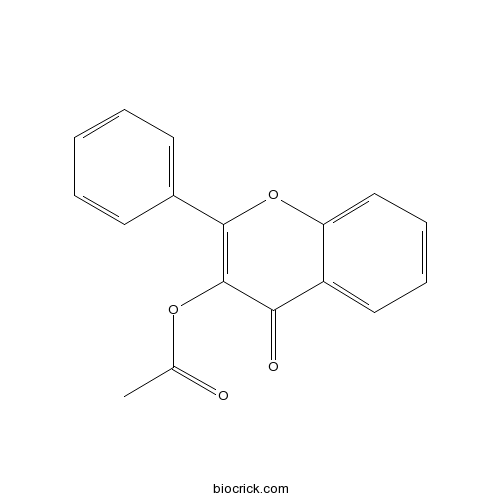3-AcetoxyflavoneCAS# 7578-68-9 |

Quality Control & MSDS
3D structure
Package In Stock
Number of papers citing our products

| Cas No. | 7578-68-9 | SDF | Download SDF |
| PubChem ID | 1666397 | Appearance | Powder |
| Formula | C17H12O4 | M.Wt | 280.3 |
| Type of Compound | N/A | Storage | Desiccate at -20°C |
| Solubility | Soluble in Chloroform,Dichloromethane,Ethyl Acetate,DMSO,Acetone,etc. | ||
| Chemical Name | (4-oxo-2-phenylchromen-3-yl) acetate | ||
| SMILES | CC(=O)OC1=C(OC2=CC=CC=C2C1=O)C3=CC=CC=C3 | ||
| Standard InChIKey | NCHSTTAWIMAJHU-UHFFFAOYSA-N | ||
| Standard InChI | InChI=1S/C17H12O4/c1-11(18)20-17-15(19)13-9-5-6-10-14(13)21-16(17)12-7-3-2-4-8-12/h2-10H,1H3 | ||
| General tips | For obtaining a higher solubility , please warm the tube at 37 ℃ and shake it in the ultrasonic bath for a while.Stock solution can be stored below -20℃ for several months. We recommend that you prepare and use the solution on the same day. However, if the test schedule requires, the stock solutions can be prepared in advance, and the stock solution must be sealed and stored below -20℃. In general, the stock solution can be kept for several months. Before use, we recommend that you leave the vial at room temperature for at least an hour before opening it. |
||
| About Packaging | 1. The packaging of the product may be reversed during transportation, cause the high purity compounds to adhere to the neck or cap of the vial.Take the vail out of its packaging and shake gently until the compounds fall to the bottom of the vial. 2. For liquid products, please centrifuge at 500xg to gather the liquid to the bottom of the vial. 3. Try to avoid loss or contamination during the experiment. |
||
| Shipping Condition | Packaging according to customer requirements(5mg, 10mg, 20mg and more). Ship via FedEx, DHL, UPS, EMS or other couriers with RT, or blue ice upon request. | ||

3-Acetoxyflavone Dilution Calculator

3-Acetoxyflavone Molarity Calculator
| 1 mg | 5 mg | 10 mg | 20 mg | 25 mg | |
| 1 mM | 3.5676 mL | 17.838 mL | 35.6761 mL | 71.3521 mL | 89.1902 mL |
| 5 mM | 0.7135 mL | 3.5676 mL | 7.1352 mL | 14.2704 mL | 17.838 mL |
| 10 mM | 0.3568 mL | 1.7838 mL | 3.5676 mL | 7.1352 mL | 8.919 mL |
| 50 mM | 0.0714 mL | 0.3568 mL | 0.7135 mL | 1.427 mL | 1.7838 mL |
| 100 mM | 0.0357 mL | 0.1784 mL | 0.3568 mL | 0.7135 mL | 0.8919 mL |
| * Note: If you are in the process of experiment, it's necessary to make the dilution ratios of the samples. The dilution data above is only for reference. Normally, it's can get a better solubility within lower of Concentrations. | |||||

Calcutta University

University of Minnesota

University of Maryland School of Medicine

University of Illinois at Chicago

The Ohio State University

University of Zurich

Harvard University

Colorado State University

Auburn University

Yale University

Worcester Polytechnic Institute

Washington State University

Stanford University

University of Leipzig

Universidade da Beira Interior

The Institute of Cancer Research

Heidelberg University

University of Amsterdam

University of Auckland

TsingHua University

The University of Michigan

Miami University

DRURY University

Jilin University

Fudan University

Wuhan University

Sun Yat-sen University

Universite de Paris

Deemed University

Auckland University

The University of Tokyo

Korea University
- Cedrusin
Catalog No.:BCN4307
CAS No.:75775-36-9
- 17-AAG (KOS953)
Catalog No.:BCC2121
CAS No.:75747-14-7
- Eupalinilide D
Catalog No.:BCN2523
CAS No.:757202-14-5
- Eupalinilide C
Catalog No.:BCN2522
CAS No.:757202-11-2
- Eupalinilide B
Catalog No.:BCN2521
CAS No.:757202-08-7
- Leflunomide
Catalog No.:BCC1256
CAS No.:75706-12-6
- 5-Amino-2-methylindole
Catalog No.:BCC8731
CAS No.:7570-49-2
- Isradipine (Dynacirc)
Catalog No.:BCC3797
CAS No.:75695-93-1
- 2,4-Dihydroxy-4,6-dimethoxydihydrochalcone
Catalog No.:BCN1363
CAS No.:75679-58-2
- 4-Acetyl-1,1-dimethylpiperazinium iodide
Catalog No.:BCC6616
CAS No.:75667-84-4
- Strobamine
Catalog No.:BCN1943
CAS No.:75656-91-6
- Boc-D-Asn-OH
Catalog No.:BCC3362
CAS No.:75647-01-7
- ADX 10059 hydrochloride
Catalog No.:BCC6171
CAS No.:757949-98-7
- Prosapogenin CP4
Catalog No.:BCN2534
CAS No.:75799-18-7
- Momordicoside A
Catalog No.:BCC8340
CAS No.:75801-95-5
- Dehydroevodiamine Chloride
Catalog No.:BCN6651
CAS No.:75853-60-0
- Rimcazole dihydrochloride
Catalog No.:BCC7090
CAS No.:75859-03-9
- 1-(3,5-Di-tert-butyl-4-hydroxyphenyl)-2-(2-(3-hydroxypropylamino)-5,6-dimethyl-1H-benzo[d]imidazol-1-yl)ethanone
Catalog No.:BCC1481
CAS No.:758679-97-9
- Bay 65-1942 R form
Catalog No.:BCC1410
CAS No.:758683-21-5
- [Nle4,D-Phe7]-α-MSH
Catalog No.:BCC5963
CAS No.:75921-69-6
- 11-Hydroxycanthin-6-one
Catalog No.:BCN3104
CAS No.:75969-83-4
- Pancreatic Polypeptide (human)
Catalog No.:BCC5711
CAS No.:75976-10-2
- Camphor
Catalog No.:BCN8297
CAS No.:76-22-2
- Triamcinolone Acetonide
Catalog No.:BCC3871
CAS No.:76-25-5
Synthesis and biological evaluation of acyl derivatives of hydroxyflavones as potent antiproliferative agents against drug resistance cell lines.[Pubmed:29116937]
Z Naturforsch C. 2018 Jan 26;73(1-2):87-93.
The synthesis of hydroxyflavone derivatives is described. The acyl derivatives of 3-, 6-, 7-hydroxyflavones (compounds 2, 4, 6, respectively) and chrysin (5,7-dihydroxyflavone, 7) were obtained in high yields and evaluated in vitro for their cytotoxic activity against several cancer cell lines of different origin: MCF-7 (breast cancer), A549 (nonsmall cell lung cancer), MES-SA (uterine sarcoma), LoVo (colon cancer), drug-resistant human cancer cells (MES-SA/DX5, LoVo/DX) and also towards non-cancer cell line MCF-10A (normal breast epithelial cells). The flavones modified with acyl group showed higher antiproliferative activity than free hydroxyflavones. The highest activity was noted for 3-Acetoxyflavone (2), which proved active against LoVo, LoVo/DX, and MES-SA cell lines (IC50 from 4.7 muM to 7.8 muM, respectively). The highest ability to overcome the barrier of resistance (resistance index=0.82) against the drug-resistant MES-SA/DX5 cells compared to the parental drug-sensitive MES-SA cell line was found for 7-acetoxyflavone (6).


